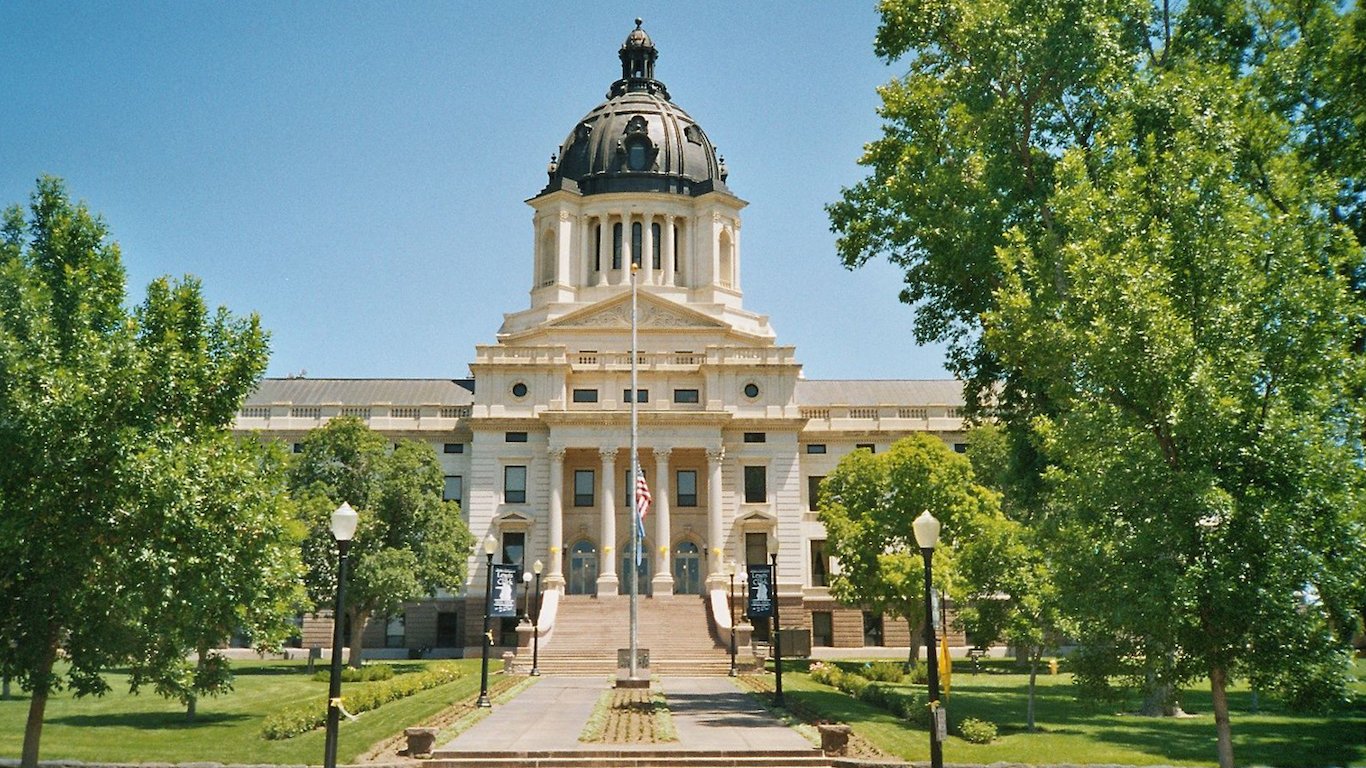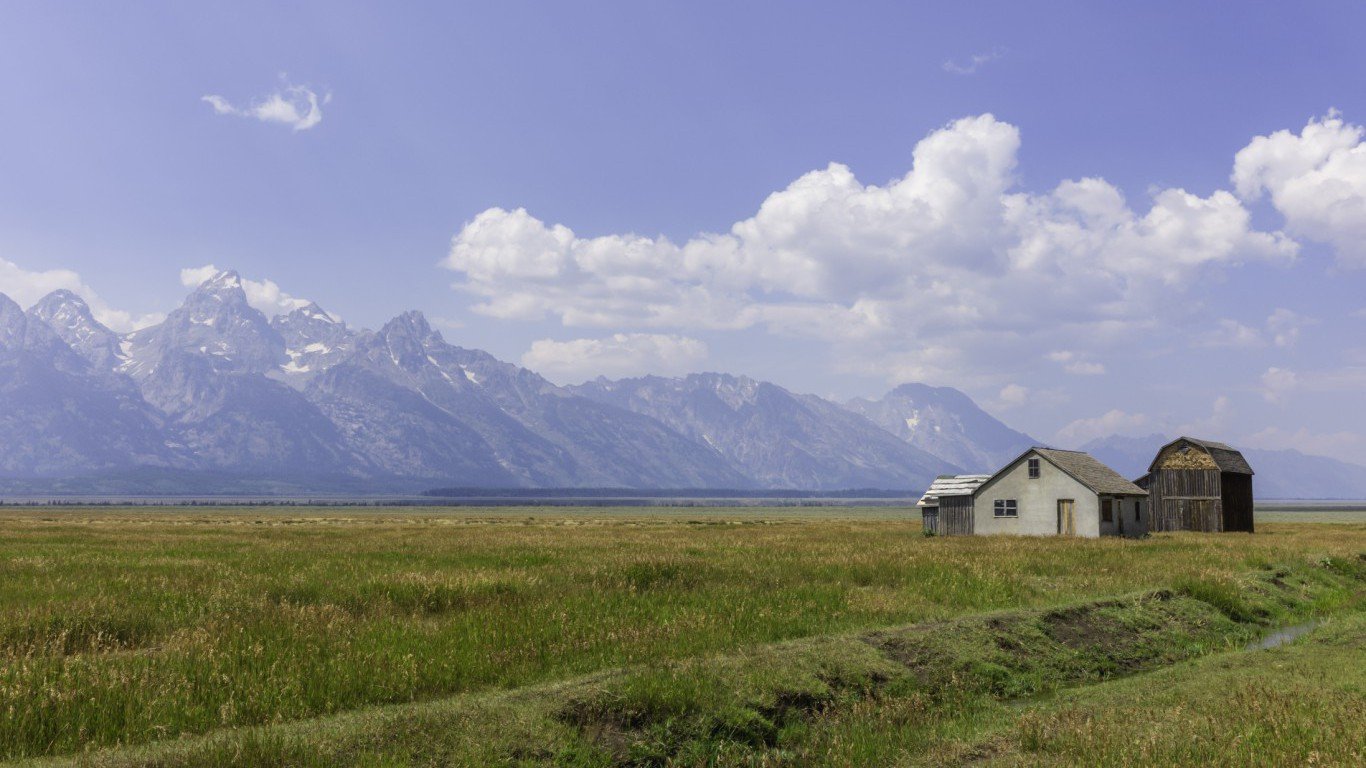Special Report
10 Worst States for Women

Published:
Last Updated:

The U.S. could elect the first female president in its history this November. For many advocates, representation in the nation’s highest office could lead to meaningful progress for women’s rights, potentially addressing some of the severe inequalities the nation has yet to overcome.
These issues include a gender pay gap, a lack of flexibility in the workplace during pregnancy and early motherhood, and, indeed, a lack of women holding positions of political influence. While some states have made progress, a number of states are far behind in closing the earnings gap, electing women to office, funding pre-K programs, and passing laws that allow women to stay in the workforce when they have children, should they so choose. 24/7 Wall St. reviewed and ranked the 50 states based on their favorability to women. These are the 10 worst states for women.
[in-text-ad]
Perhaps the most egregious component of gender inequality in the U.S. is the wage gap. Though the severity of the wage gap varies by state, nationwide, the typical woman working full time earns 80 cents for every dollar a man earns. No state has a larger gap than Wyoming, however, where women earn roughly 64 cents for every dollar. With lower incomes, women are also far more likely to live in poverty than men.
Click here to see the 10 worst states for women.
Click here to see a review of gender equality in all 50 states.
In an interview with 24/7 Wall St., Julie Anderson, a research associate at the Institute for Women’s Policy Research, explained why the wage gap exists. According to Anderson, “the largest contributor to the wage gap is occupational segregation.” Men are more likely to be hired in higher paying, managerial roles than women. Though the share ranges from state to state, nationwide, fewer than 40% of management positions are held by women.
According to Anderson, women are also far more likely than men to work in low wage, part-time jobs. Since the wage gap only measures the incomes of men and women working full time, the problem is even more pronounced than the data indicates.
Maternity, Anderson explained, can lead to lower overall incomes for women, particularly as raising a child can often lead women to exit the workforce for good. “If a family has to choose between someone being fully engaged in work and someone being a caregiver, the logical choice is the one who earns less will be the one to back off, and in most cases that will be the woman in the family.”
While the Family & Medical Leave Act of 1993 mandates that most working mothers must be allowed 12 weeks maternity leave, a number of states have additional policies in place both for public employees and the private sector workforce. Many states extend the minimum number of weeks, allow women to use sick days to cover pre- and post-natal care, and, in some cases, mandate paid leave for both mothers and fathers.
Another state policy that has shown to be advantageous to young mothers is a taxpayer-funded pre-Kindergarten program. Besides being instrumental in childhood development, pre-K programs give parents the opportunity to leave their children somewhere safe during the day.
Anderson explained that as mothers are more often tasked with the responsibility of watching young children, this means women avoid the expenses of private daycare, and also will have an easier time returning to the workforce. Eight states have no taxpayer-funded pre-K, and partially as a result rank among the worst for women in the country.
Female representation in government is also an important aspect of gender equality, and elected government positions are held primarily by men. Nearly half of all states have never had a female governor and women comprise an average of less than 25% of state legislatures. According to Anderson, this is problematic both because it may discourage women from running for elected office and because male politicians are less likely to implement reform related to gender equality. Anderson explained that while women are less likely to run for office, when they do, they tend win at the same rates as men.
Click here to see our methodology.
These are the 10 worst states for women.

10. Kansas
> Female earnings as pct. of male: 76.6% (15th lowest)
> Pct. mgmt. jobs held by women: 35.9% (7th lowest)
> Pct. 3-4 yr. olds enrolled in state pre-K: 10.1% (25th highest)
> Pct. legislative seats held by women: 24.8% (25th lowest)
When women hold elected office, they are more likely to introduce legislation that helps marginalized groups. In Kansas, less than a quarter of the state legislature is comprised of women and only one of the six elected officials that represent the state on Capitol Hill is female.
[in-text-ad]
With few female lawmakers, Kansas does not offer some protections that are common elsewhere for women in the workforce. There are no major state mandated pregnancy accommodations and no paid family leave for either private or public sector employees.

9. Alabama
> Female earnings as pct. of male: 76.1% (13th lowest)
> Pct. mgmt. jobs held by women: 38.7% (17th lowest)
> Pct. 3-4 yr. olds enrolled in state pre-K: 6% (20th lowest)
> Pct. legislative seats held by women: 14.3% (5th lowest)
Alabama has one of the highest poverty rates in the country, and it is an even greater problem for women in the state. One in four women live in poverty, and they account for 56.5% of the state’s poor population. The state’s substantial wage gap is a significant contributing factor. The typical female worker in the state earns 76 cents for every dollar earned by her male counterpart.

8. Montana
> Female earnings as pct. of male: 72.5% (6th lowest)
> Pct. mgmt. jobs held by women: 37.9% (11th lowest)
> Pct. 3-4 yr. olds enrolled in state pre-K: 0% (the lowest)
> Pct. legislative seats held by women: 31.3% (8th highest)
By some measures, Montana has a history of giving women opportunities to influence public affairs. In 1914, several years before the 19th Amendment was passed, Montana became one of the first states in the country to give women the right to vote. Today, women account for more than 30% of the state legislature, a higher share than in most states.
However, the state is behind by some other important measures of women’s equality. For example, it is one of just eight to have no state-funded pre-K programs.

7. Indiana
> Female earnings as pct. of male: 75.9% (12th lowest)
> Pct. mgmt. jobs held by women: 40.8% (17th highest)
> Pct. 3-4 yr. olds enrolled in state pre-K: 0% (the lowest)
> Pct. legislative seats held by women: 20.7% (16th lowest)
State-funded day care programs are important as their presence means families are not forced to make tough decisions in balancing careers and child care. Indiana does not offer taxpayer-funded pre-K, however, and as a result, many parents with young children must either leave the workforce or incur the high cost of private daycare.
[in-text-ad]
Women are also less likely to hold elected office in Indiana than in most other states. In the 200 years since Indiana became a state, a woman has never once been elected governor.

6. North Dakota
> Female earnings as pct. of male: 71.1% (5th lowest)
> Pct. mgmt. jobs held by women: 31.1% (2nd lowest)
> Pct. 3-4 yr. olds enrolled in state pre-K: 0% (the lowest)
> Pct. legislative seats held by women: 19.1% (13th lowest)
One of the most important measures of women’s equality in the workplace is their ability to be promoted to higher-paying roles. In North Dakota, just 31.1% of all management occupations are held by women, a smaller share than in any state except for South Dakota.
North Dakota is one of just eight states with no pre-K funding, which can help young families save money on childcare, and makes it easier for mothers to return to work after having children.

5. South Dakota
> Female earnings as pct. of male: 78.1% (20th lowest)
> Pct. mgmt. jobs held by women: 29.3% (the lowest)
> Pct. 3-4 yr. olds enrolled in state pre-K: 0% (the lowest)
> Pct. legislative seats held by women: 21.0% (18th lowest)
There are eight states that provide no pre-K funding, and South Dakota is one of them. With no state-funded pre-K program, women with young children are less likely to be able to participate in the workforce, ultimately making them more likely to be financially dependent.
Those women who are working in the state earn considerably less than their male counterparts. The typical full-time salary among women in the state is only $33,268, well below the $42,605 salary of the typical male worker in South Dakota.

4. Utah
> Female earnings as pct. of male: 71.1% (4th lowest)
> Pct. mgmt. jobs held by women: 34.5% (4th lowest)
> Pct. 3-4 yr. olds enrolled in state pre-K: 0% (the lowest)
> Pct. legislative seats held by women: 15.4% (7th lowest)
Few states have a wider gender pay gap than Utah. The typical male worker in the state is paid $50,741, while his female counterpart earns $36,060, or nearly $15,000 less.
[in-text-ad]
The substantial gap between male and female earnings in Utah is likely due in part to unequal pay for the similar work. It can also potentially be attributed to the kinds of jobs women tend to hold in the state. If educational attainment is any indication, Utah women may be less represented in jobs that require a college degree, and are usually higher-paying. Just 29.3% of state women have a college education, compared to 34.4% of men in the state.

3. Idaho
> Female earnings as pct. of male: 73.5% (8th lowest)
> Pct. mgmt. jobs held by women: 38.8% (19th lowest)
> Pct. 3-4 yr. olds enrolled in state pre-K: 0% (the lowest)
> Pct. legislative seats held by women: 27.6% (17th highest)
The earnings gap between men and women in Idaho is one of the worst in the country. The typical male in the state working full time earns $43,264, while the typical working female earns only $31,808, the lowest median salary of any state except Mississippi.
[in-text-ad]
In addition to earning less, women are underrepresented in public office. All four of the state’s congressional delegates are men and a woman has never been elected governor of Idaho.

2. Wyoming
> Female earnings as pct. of male: 64.4% (the lowest)
> Pct. mgmt. jobs held by women: 39.1% (21st lowest)
> Pct. 3-4 yr. olds enrolled in state pre-K: 0% (the lowest)
> Pct. legislative seats held by women: 13.3% (2nd lowest)
In 1869, Wyoming became the first state in the country to grant women’s suffrage, roughly five decades before Congress passed the 19th Amendment. Despite being a leader in this important milestone, conditions in Wyoming today are some of the least favorable for women.
No state, for example, has a wider gender pay gap than Wyoming. The typical female worker earns $36,064, or just 64.4% of the $55,965 male median earnings in the state.

1. Mississippi
> Female earnings as pct. of male: 75.7% (11th lowest)
> Pct. mgmt. jobs held by women: 38.4% (16th lowest)
> Pct. 3-4 yr. olds enrolled in state pre-K: 2.2% (14th lowest)
> Pct. legislative seats held by women: 17.2% (10th lowest)
While poor economic conditions affect many Mississippi residents, women are more likely to be negatively affected. The typical salary among women working full time in Mississippi is $31,110, the lowest of any state in the country and equal to roughly $0.76 for each dollar earned by men in the state.
The workplace in Mississippi, for both private and public sector jobs, is not especially accommodating for pregnant women or those with families, as Mississippi has not passed any significant legislation expanding on federal protections laid out in 1993’s Family & Medical Leave Act. The lack of consideration for working women may be due in part to a lack of female leadership in state government. Only 17% of Mississippi’s legislature is female, one of the smallest such shares in the country.
Methodology:
To determine the worst states for women, 24/7 Wall St. developed a methodology based on the Center for American Progress’ 2013 report, “The State of Women in America.” In its third year, our report utilized the same methodology as last year, making state rankings, and state improvements or declines relative to the 2015 report, directly comparable.
We divided a range of variables into three major categories: economy, leadership, and health. Unless otherwise noted, all data are for 2015. Data in the economy category came from the U.S. Census Bureau and included male and female median earnings for full-time, year-round work as well as high school and bachelor’s educational attainment rates. The percent of children enrolled in state pre-kindergarten and state spending per child enrolled in pre-kindergarten came from the National Institute for Early Education Research.
[in-text-ad]
The leadership category included data on the percent of women in management occupations from the Census. It also included the share of state and federal legislators who are women from the National Conference of State Legislatures and the U.S. House of Representatives Archives, respectively. From the National Governors Association, we also looked at states that currently have female governors. Data on political representation are current as of this writing.
The health section incorporated Census data on the percent of women who were uninsured. Female life expectancy came from the Institute for Health Metrics and Evaluation, an independent health research center affiliated with the University of Washington. Additionally, we looked at infant mortality rates from the Centers for Disease Control and Prevention, as well as maternal mortality rates from the National Women’s Law Center. State policies relating to maternity leave, sick days, and time off came from the National Partnership for Women and Families. Data on a state’s decision to expand Medicaid under the Affordable Care Act came from the Department of Health and Human Services.
State rankings on each of these measures were averaged to determine a score for each category. Possible scores ranged from 1 (best) to 50 (worst). The three category scores were averaged to create an indexed value that furnished our final ranking.
Take the quiz below to get matched with a financial advisor today.
Each advisor has been vetted by SmartAsset and is held to a fiduciary standard to act in your best interests.
Here’s how it works:
1. Answer SmartAsset advisor match quiz
2. Review your pre-screened matches at your leisure. Check out the
advisors’ profiles.
3. Speak with advisors at no cost to you. Have an introductory call on the phone or introduction in person and choose whom to work with in the future
Take the retirement quiz right here.
Thank you for reading! Have some feedback for us?
Contact the 24/7 Wall St. editorial team.